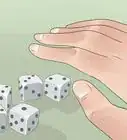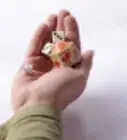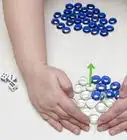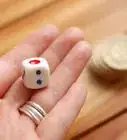wikiHow is a “wiki,” similar to Wikipedia, which means that many of our articles are co-written by multiple authors. To create this article, 44 people, some anonymous, worked to edit and improve it over time.
There are 9 references cited in this article, which can be found at the bottom of the page.
This article has been viewed 512,674 times.
Learn more...
A loaded die, also known as a weighted or crooked die, can be used to amaze, confuse, or to conquer. By altering the weight distribution in a die, you can get it to land more often on the side of your choice. Whether you want to pull off some improbable magic tricks or dominate craps, learning to load a die can be a fun trick.[1] You can learn to drill, create a variable-load die, or melt the die gently to produce the intended effect.
Steps
Drilling the Die
-
1Get the necessary materials. The most traditional way of loading a die involves simple tools and supplies that you can get at any home repair store or hardware outlet. Try to get a big package of dice so that you'll be able to try a few different techniques to get it right. It's also good to have:
- Power drill
- Small gauge drill bit (no larger than the size of each dot on the die)
- Small gauge nail or lead pellets
- Super glue
- Paint or white-out
- Several dice for weighting
-
2Decide which side you want to weight. The most straightforward way of "gimmicking" or "loading" a die is by drilling into the plastic and weighting it on one side to try to make that end land down more often. So you need to pick which side you want to come up most often, and weight the opposite side.
- Any number that you know and your opponents don't know will be effective, but if you're going to gimmick some dice for the purposes of playing craps, you might want to weight them so that six comes up most often, or else you might want to weight another number to ensure that other rollers will crap out. It's up to you.
Advertisement -
3Drill straight into the die. You want to hollow out as little of the plastic as possible, to avoid drawing attention to the gimmick. Ideally, a drill bit should be used that’s no larger than 1/16th of an inch. You can use it to gently open up the hole and clear space for the weight.
- Clamp the die in a vise to protect your fingers. Never try to hold the die while you drill into it at the same time.
- Drill into the center of the die, staying as straight as possible to avoid drawing attention to your hole. Leave the edges smooth so you can easily pass the weight through it.
-
4Insert a small nail or lead pellets. A common weight is a thin nail or pin, used to load one side of the die. It needs to match the diameter of the hole, usually about a sixteenth of an inch.
- If you use a nail, take wire cutters or small bolt cutters and snip some weight off the end after you've inserted it into the die. If you use tiny bearings, push them in and use a needle to set them deeper into the die. It should be as close to the edge as possible though, or you'll ruin the effect of the weight.
- Go back over the end with some sandpaper or a metal file to smooth it out. If any of the metal extends past the end of the die, you need to smooth it off. Nothing will get you caught more quickly than some rough metal sticking out.
-
5Add glue to seal the weight. Use a small amount of super glue to seal up the end of the hole that you just loaded. You'll need a small amount of super glue to plug the hole and make sure the weight doesn't come back out.
- After adding glue, let it dry thoroughly and go back over it again with fine-grain sandpaper to smooth out any little bumps. Use your finger to feel the other dots on the die and make the gimmicked spot match it.
-
6Paint over the weight. Use a little bit of dark ink, Sharpie, or gun-black to color in the fake spot that you've weighted. Make sure it matches the other spots as closely as possible. Coloring over the weight will help make or break the trick. Don't get caught in your gimmick by messing up the color and getting it on the white part of the die. Be especially careful to keep your coloring in the lines of the dot, making it evenly marked and uniform.
- The dots on standard dice are usually shiny and pure black. India ink is likely the smartest choice for the job. Use a new, fine-tipped brush and maintain a very sharp point. If you want, you could even outline the dots with very thin strips of masking tape, to keep ink from getting on the white part of the die.
Melting The Dice
-
1Place aluminum foil on a cookie tray. If you don't want to drill, a quicker method is melting. To make sure you don't get smelly, stuck-on plastic all over your oven, line a cookie sheet with aluminum foil to keep everything safe. Do this in a well-ventilated area with the windows open, and keep close watch on the die while you do this. It's easy to go too far, so you need to watch closely.[2]
- Another easy way of weighting the die is to melt it gently, just enough to shift the weight slightly onto the bottom of the die and change the effect of the rolling. You have to be extremely careful to avoid melting the die too much and changing the appearance of the die. It won't take much just to soften the plastic, widen the base of the opposite side, and land more regularly on that side.
-
2Heat a toaster oven or convection oven to roughly 200 °F (93 °C). Keeping the temperature at a low setting will help ensure that you don't overdo it. 200 degrees isn't much, but it'll be plenty to heat and soften the plastic and change the shape of the die slightly.
- Do not use the microwave. It will not melt the die the way you want, and you're more likely to warp the plastic and make it look funny. It's also dangerous. Avoid microwaving dice.
-
3Place the die in the oven with the number you want up. Keep a close watch on the die and remove it before 10 minutes have passed. Remove the die using gloves, and dump it immediately into icy water to set the plastic and make sure it won't continue melting.
- If you notice any bubbling or see that the shape has changed slightly, remove the die immediately and try it again, going for slightly less time. You should ideally remove the die before you notice any change, so it might take some practice runs. [3]
- Keep the room properly ventilated.[4] Inhaling melting plastic fumes is hazardous, and you need to be extremely careful that you only melt the plastic but don't burn it and start a fire.
-
4Test the dice a few times. Go for a few rolls and test your new gimmicked die. If you're more consistently landing on the side you want to land on, you've got a good loaded die. If it's not working like you want, you can try to re-melt it, or you can just start over with a new die.[5]
Variable-Load Dice
-
1Drill out several dots. If you want to get really elaborate by making a die that is adjustable, you have to open up the inside of the die without visibly altering the outside. This will take some practice and some patience to get it right, but it's possible if you start by drilling out several of the holes on different sides of the die, using a thin drill bit.[6]
- Make as few holes as possible. If you're struggling to scrape out the interior, however, you will need to make several holes. In that case, it may be better to drill out all the holes, so at least they'll be uniform.
-
2Hollow out the die carefully. The best tool for hollowing out a die is a dentist’s pick or another small poking device. Carefully and gently scrape out the interior of the die a little bit at a time. If you can work the pick into each hole, scrape out as much as possible from each different angle. Eventually you should be able to hollow out the entire interior.
- From each angle go as deep as you can and try to scrape out as much as you can. You won't be able to hollow out the entire die from one side, but you can get it all by approaching it from several directions.
-
3Plug all the holes but one. Smear some super glue over each hole and let it dry. This will help contain the weight you insert. Don’t worry if the glue makes the die look different. You can smooth it up later using fine-grained sandpaper and some care. Now, you're just trying to get the weight correct.
-
4Drop a few lead weights into the center of the die. Fit a few small bearings into the middle of the die. You want to get the final weight of the die to match the basic weight of a normal die, so keep a normal die on hand to compare while you're working. The average handler won't notice subtle differences, but you don't want your weighted die to feel hollow and fake.[7]
- Insert a few small lead bearings into the open hole. Feel the heft of it and add more if necessary. They'll be rattling around on the inside, but don't worry about the sound. You'll take care of that with the next step.
-
5Mix paraffin and coconut oil. You're going to fill the die with a mixture of waxes that will be hard enough to secure the bearings and hold them still at a cool temperature but soft enough that you'll be able to melt it with body heat–the heat from your clenched hand. The ideal mixture is paraffin and coconut oil, both commonly available and relatively cheap.[8] You will mix them together to form a solid but meltable mixture that you can create quickly at home.
- In a pan melt your paraffin to liquid. Add 80% more coconut oil to the wax and mix thoroughly in a bowl. Let harden.
- Test the consistency of the mixture by holding some in your hand and letting it melt back to liquid. If it’s too difficult to melt, add more coconut oil. If it’s too easy, add more paraffin.[9] When you're satisfied with the consistency fill the die with the wax mixture.
-
6Seal the last hole. Go back over the hole thoroughly with glue, taking care to fix up any cracks, gaps, and other little leaks that might have resulted from your drilling. This is a much messier process than the single-hole method, so it'll take some work to clean everything up, color it, and make it look like a normal die. Spend some time making it look right.
-
7Palm the die to cheat. When you’re ready to use the die, hold it firmly with the side you want facing up. The wax will slowly melt, allowing the weights to sink to the opposite side, weighting the die. Let it sit on the counter, or put it in the fridge for a few minutes to reset the wax and keep the die weighted.[10]
Community Q&A
-
QuestionWould a microwave be a substitute for an oven?
 Community AnswerDo not use the microwave. It will not melt the die the way you want, and you're more likely to warp the plastic and make it look funny. It's also dangerous.
Community AnswerDo not use the microwave. It will not melt the die the way you want, and you're more likely to warp the plastic and make it look funny. It's also dangerous. -
QuestionFor using an oven, would it be recommended to only use straight-cornered dice, or can I get the same results - without it being obvious - on a die with rounded corners? What about clear-colored dice?
 Community AnswerClear-colored dice would give it away. Rounded corners would also give it away. To get the best result, use regular non-rounded dice.
Community AnswerClear-colored dice would give it away. Rounded corners would also give it away. To get the best result, use regular non-rounded dice. -
QuestionWill this work with polyhedral dice like D20s?
 Community AnswerYes, but to less effect the more sides there are. Also, you'll want to use a die with similar numbers near each other. If the 20 is next to the 1, then weighting it toward the 20 won't do much.
Community AnswerYes, but to less effect the more sides there are. Also, you'll want to use a die with similar numbers near each other. If the 20 is next to the 1, then weighting it toward the 20 won't do much.
Warnings
- Allow heated dice to cool before touching them with bare hands.⧼thumbs_response⧽
- Use caution when dealing with any hot substance.⧼thumbs_response⧽
Things You'll Need
- Two sets of dice
- Oven
- Quick-drying wax
- Drill
- Vise
- Very small drill bit
References
- ↑ https://www.gamblingonline.com/craps/strategy/loaded-dice/
- ↑ https://ourpastimes.com/load-dice-yourself-8067986.html
- ↑ http://www.thebrothersgraham.com/loading.html
- ↑ https://ourpastimes.com/load-dice-yourself-8067986.html
- ↑ https://www.youtube.com/watch?v=dURhrY9Z-xg
- ↑ https://www.popularmechanics.com/home/how-to-plans/a13794530/how-to-make-loaded-dice/
- ↑ https://www.youtube.com/watch?v=iFOleDzZiJs
- ↑ https://www.keapbk.com/blogs/keap/what-is-coconut-wax-vs-coconut-oil-the-difference
- ↑ http://www.candlecauldron.com/waxandwicks.html
About This Article
If you want to load dice, try heating them in the oven. First, place the dice in an oven at 200 degrees Fahrenheit with the side you want to come up more often facing up. After 10 minutes, remove the dice and place them into cold water. This will slightly expand 1 side of the dice, making them more likely to land on the opposite side. For tips on how to variably load dice, read on!



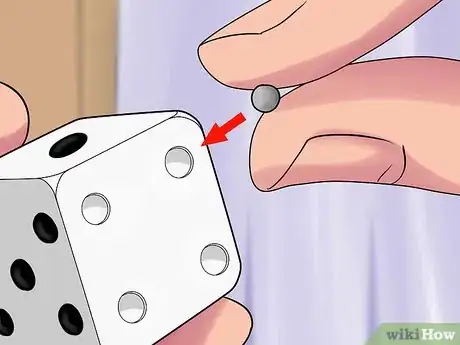


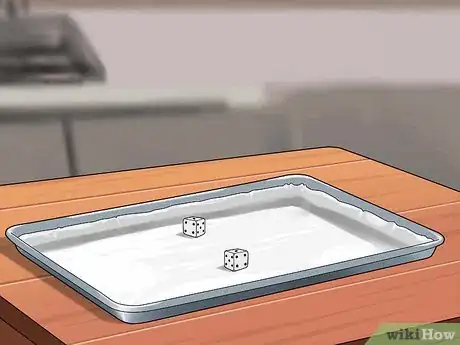

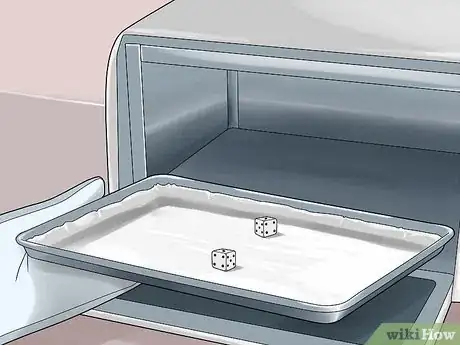


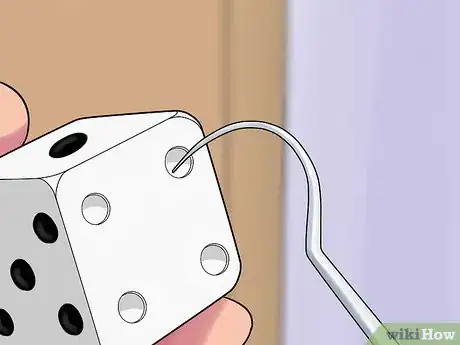
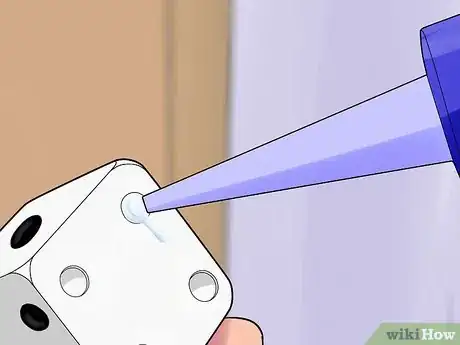
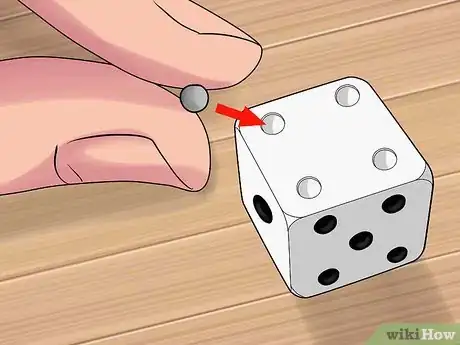
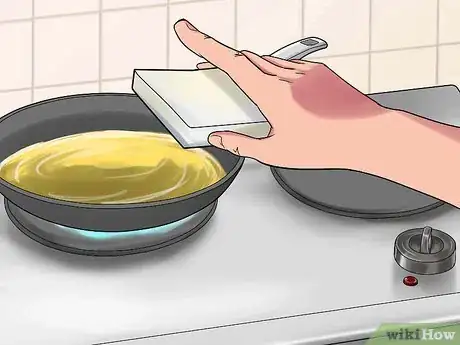
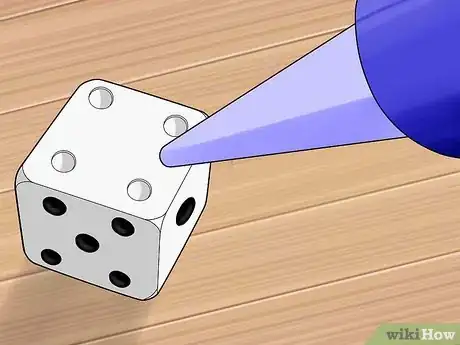
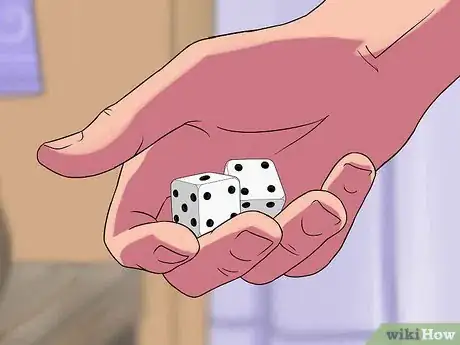

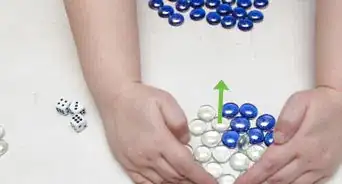
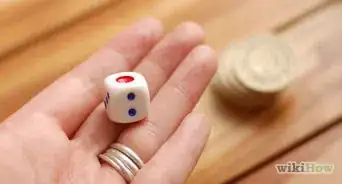
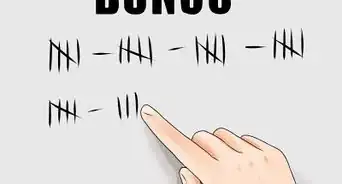
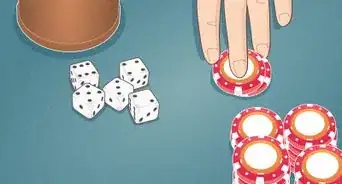

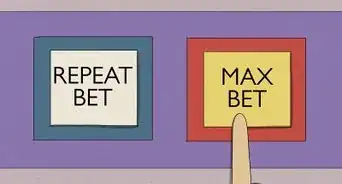

-Step-35.webp)
-Step-10.webp)









